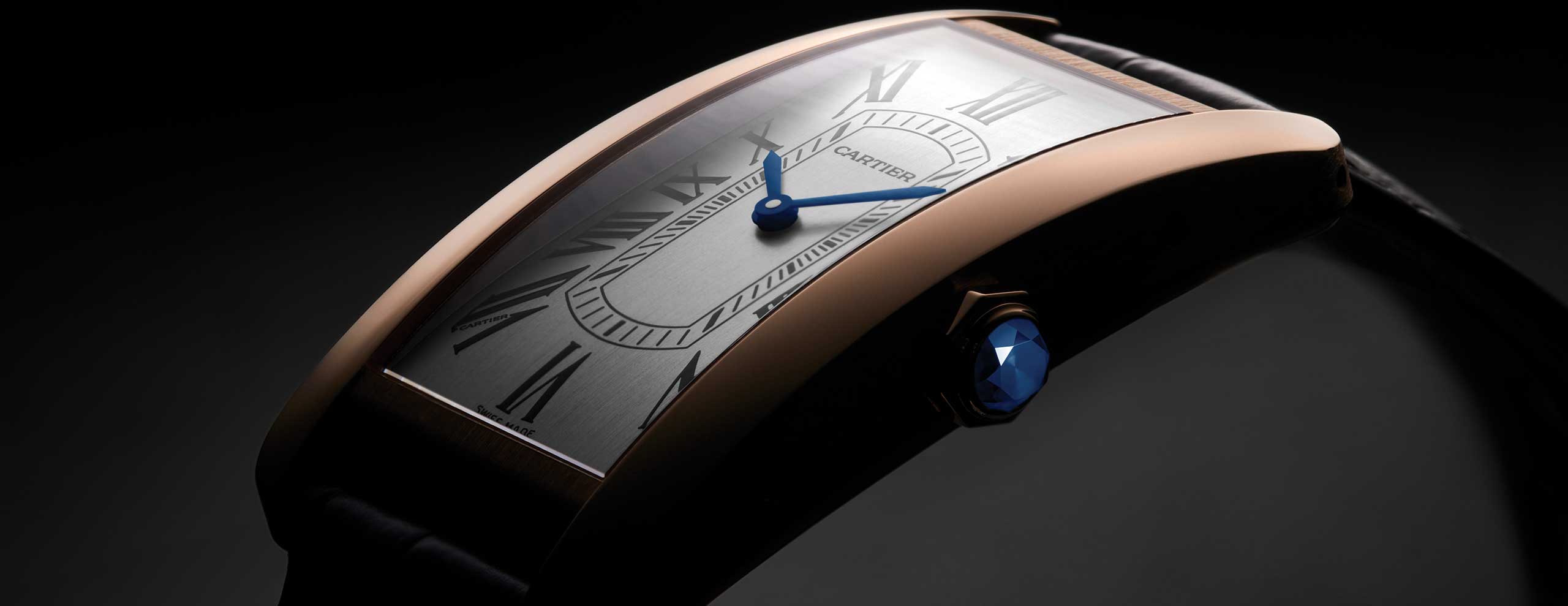Exploring the timeless design and global story and of the Cartier Tank, from Américaine to Française.
The Cartier Tank is more than an exceptional, iconic watch; it’s a genuinely legendary design. The Tank has earned its place in industrial design Valhalla as one of the greatest examples not just of watch design, but of fine product design more broadly. Its longevity and heroic stature were not the result of luck or circumstance. Rather, it is thanks to the careful consideration of generations of designers and craftspeople who understand how special this seemingly simple shaped watch is, and work exceptionally hard to maintain and honor its tradition and the culture around it. The result is that the essential design of the Tank is a material object that transcends time and geography. Regardless of whether it is worn in London in the Swinging Sixties or Sydney today, the Cartier Tank still stands for elegance. Of course, there’s been an immense amount of variation among the many models of the Tank; its fundamental lines promote diversity and innovation rather than monotony. From its early beginnings to models inspired by America and France, we explore just how the Cartier Tank has conquered the world.
One man uniquely well suited to explaining and exploring the Cartier Tank’s history and its role as a design icon is Pierre Rainero, Cartier’s Image, Style and Heritage Director. For Rainero, the key to the Tank’s success is simple — literally. “As far as the idea of the Tank, and why it is so strong, is because it’s the simplest design for a watch to be worn on the wrist. When you think of it, a watch on the wrist is a case attached to two parts of a strap or bracelet, and when you think that this case has been designed with two parallel lines to attach a strap, there’s no idea more simple than that.”
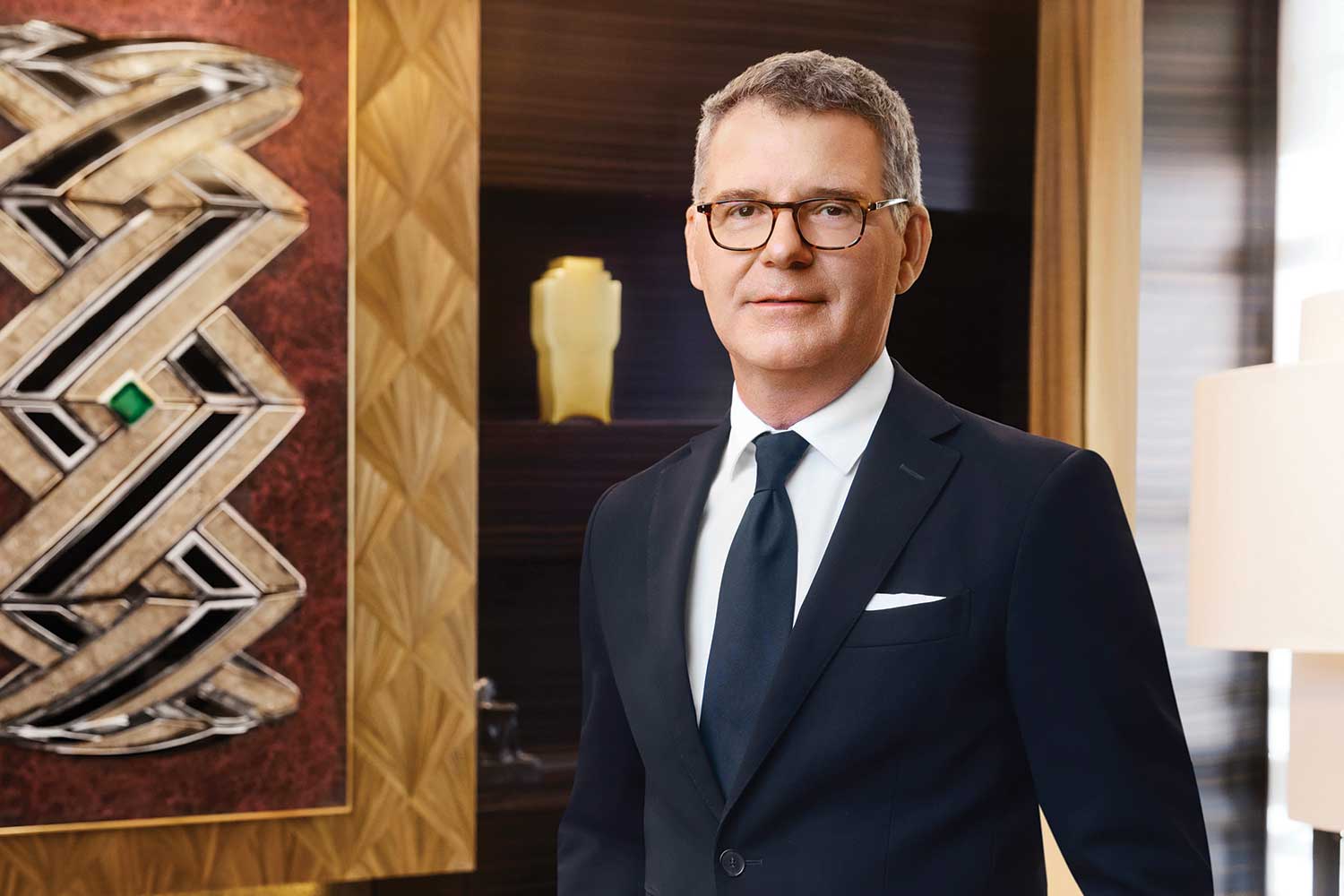
Pierre Rainero, Cartier’s Image, Style and Heritage Director
Simple as it may seem, the idea at the core of the Tank has certainly endured, though not through chance. Rainero explains how the earliest days of the Tank were some of its most formative: “The first Tank was designed, as you know, in 1917. The design was called Normale a few years later. It was a square dial within a rectangle. Louis Cartier himself, I think it was in 1921, wanted to make it even purer. So, he got rid of the two perpendicular case elements, and the Louis Cartier model was born. It was his intention, and it’s very rare in our archives that a specific object is named after Louis Cartier. That model has born his name since 1921, and it shows the will he had to modify the original shape. That’s when the previous model was named the Tank Normale. The Louis Cartier model was seen as something less square and even more refined.”
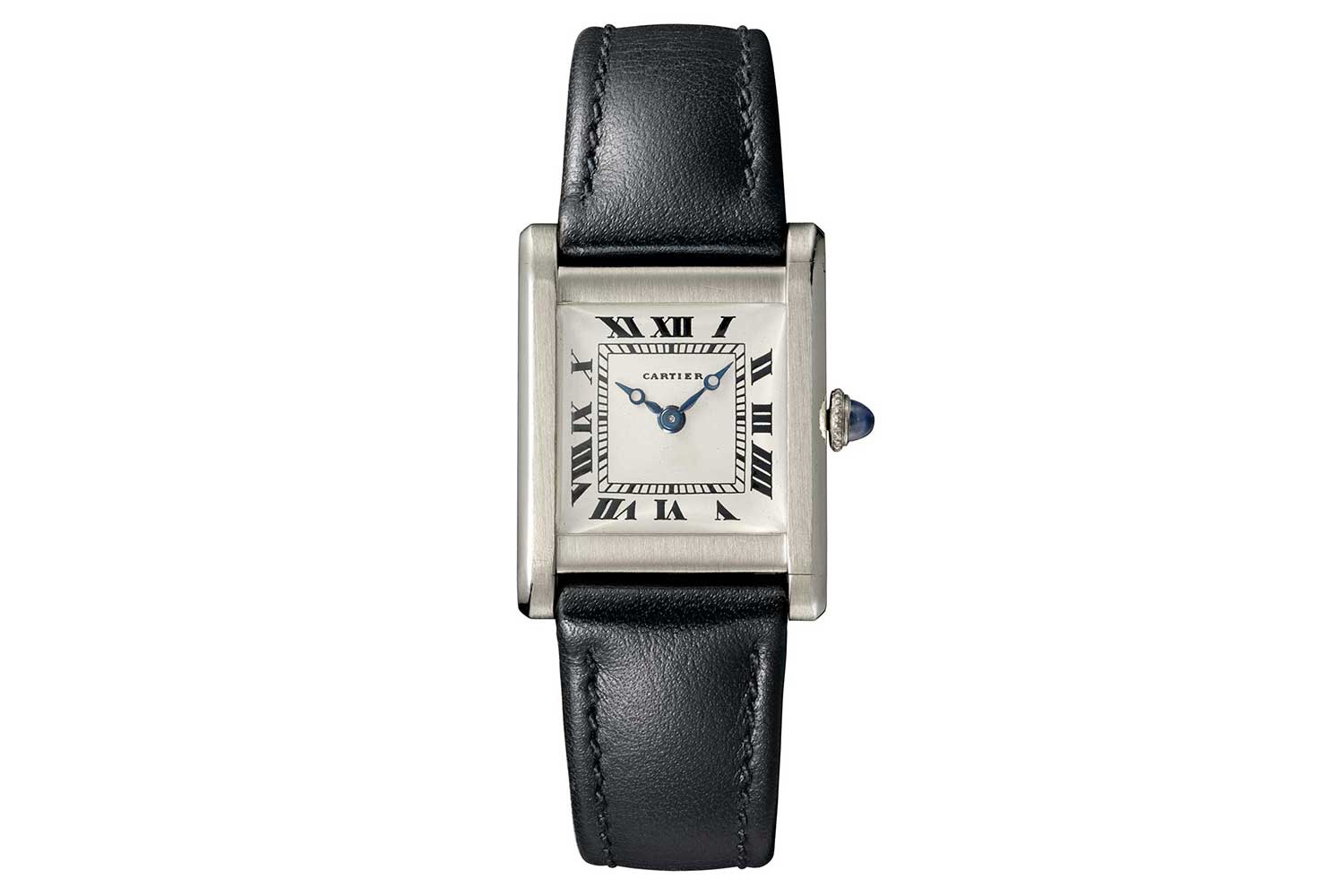
The original Tank was first designed by Louis Cartier in 1917, inspired by the top profile of the new Renault FT-17 tanks that fought in the World War I. It was introduced to the public in 1919 in a series of only six pieces. With its angular brancards, it is now known as the Tank Normale to differentiate it from the Tank Louis Cartier, which has rounded brancards. This example dates from 1920. (Image: Cartier)
For another brand, this evolution of an early design would be par for the course. After all, it’s perfectly normal for a watch design to have a dynamic relationship with the world around it — sizes go up and down, case materials go in and out of vogue. But in the case of Cartier, the emergence of the hallowed Louis Cartier design speaks to a deeper truth. “This new design shows two things,” elaborates Rainero. “It shows the solution in terms of design was really very clever, and it also shows that — through a specific effort from Louis Cartier — it was a deliberate aim to achieve the simplest possible design for a watch worn on the wrist.”
At the very dawn of the wristwatch, this early drive for superior design didn’t just create one of the most enduring watches of all time; it, as Rainero explains, fostered a culture of design within the brand. “As a result, I think there’s been no equivalent to the Tank on the market since then. There’s no other possibility to design that is simpler. It’s also a great example of a certain notion we have at Cartier, how we convey the notion of elegance. Of course, elegance is a very subjective idea, perhaps the most subjective. But at Cartier, we have a definition: ‘nothing too much’. There needs to be a balance in the effort we make to design things. Not to create something that looks too busy or too heavy. There’s another virtue, another quality from the Tank, which is the idea of comfort when you wear it, and that’s very important.”
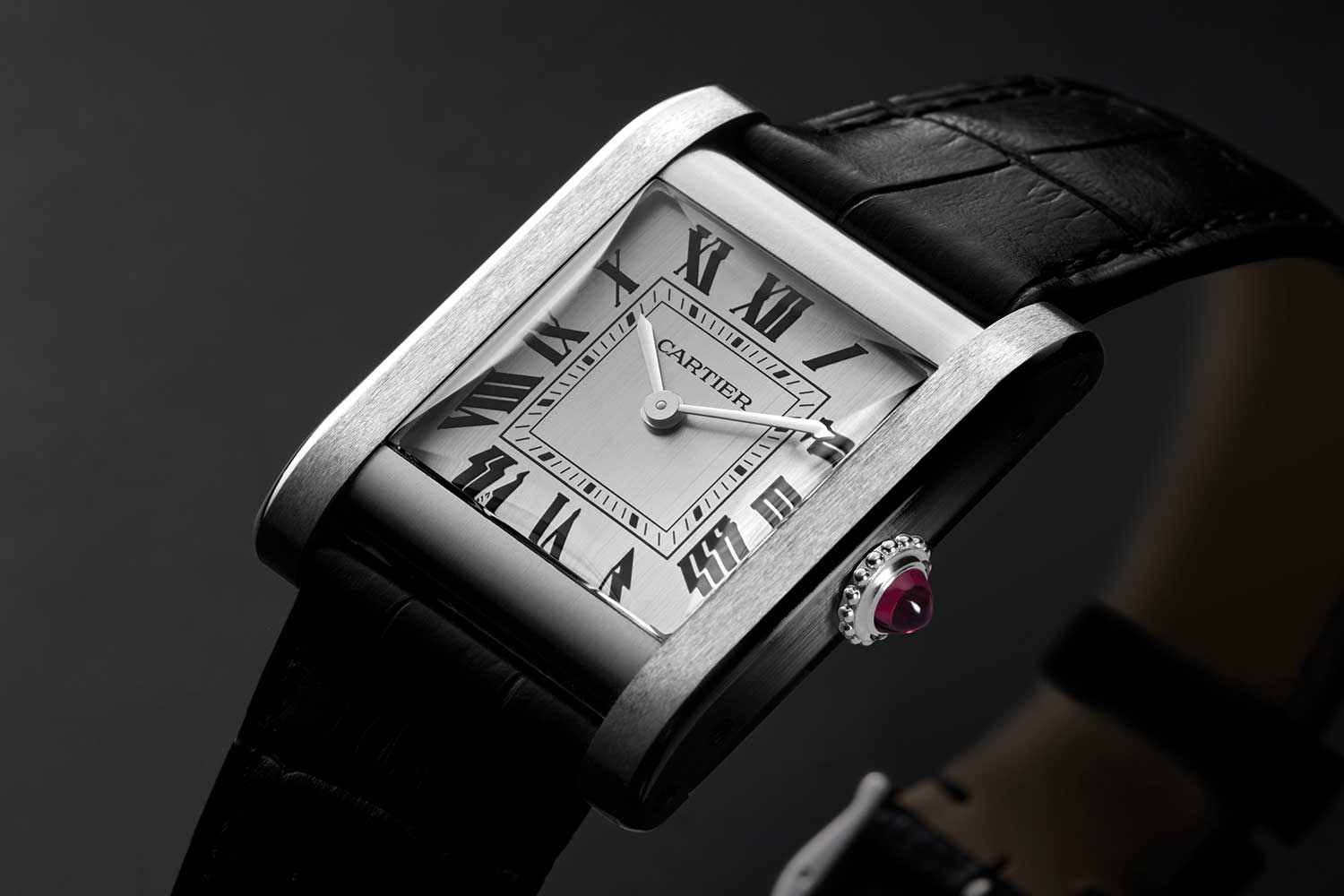
Cartier Privé Tank Normale
Earlier this year, the Tank Normale, the one that started it all, returned triumphantly to the Cartier catalog, making a special appearance as part of the limited-edition Cartier Privé collection. There are actually quite a few versions on offer, including 50 pieces in yellow gold and another 50 in platinum with a contemporary skeleton movement, and an even more limited fully-set version. The version that will resonate most strongly with collectors, however, has to be the more faithful interpretation of the original, offered in yellow gold and platinum, and featuring many details inspired by the century-old design. The beveled sapphire crystal is a lovely touch, and the Roman dial with inner railroad track is pure Cartier, while the hidden ‘1917’ date on the VII numeral is a particularly nice touch. Size-wise, these models are a little more modern in proportion, measuring 35.2mm by 27.8mm across. The most exciting detail, though, is the bracelet option. For the first time in a Cartier Privé release, Cartier has offered a matching precious-metal bracelet. The seven-link bracelet matches the brushed satin finish of the case, creating a perfectly flowing whole that certainly lives up to Cartier’s notions of elegance.
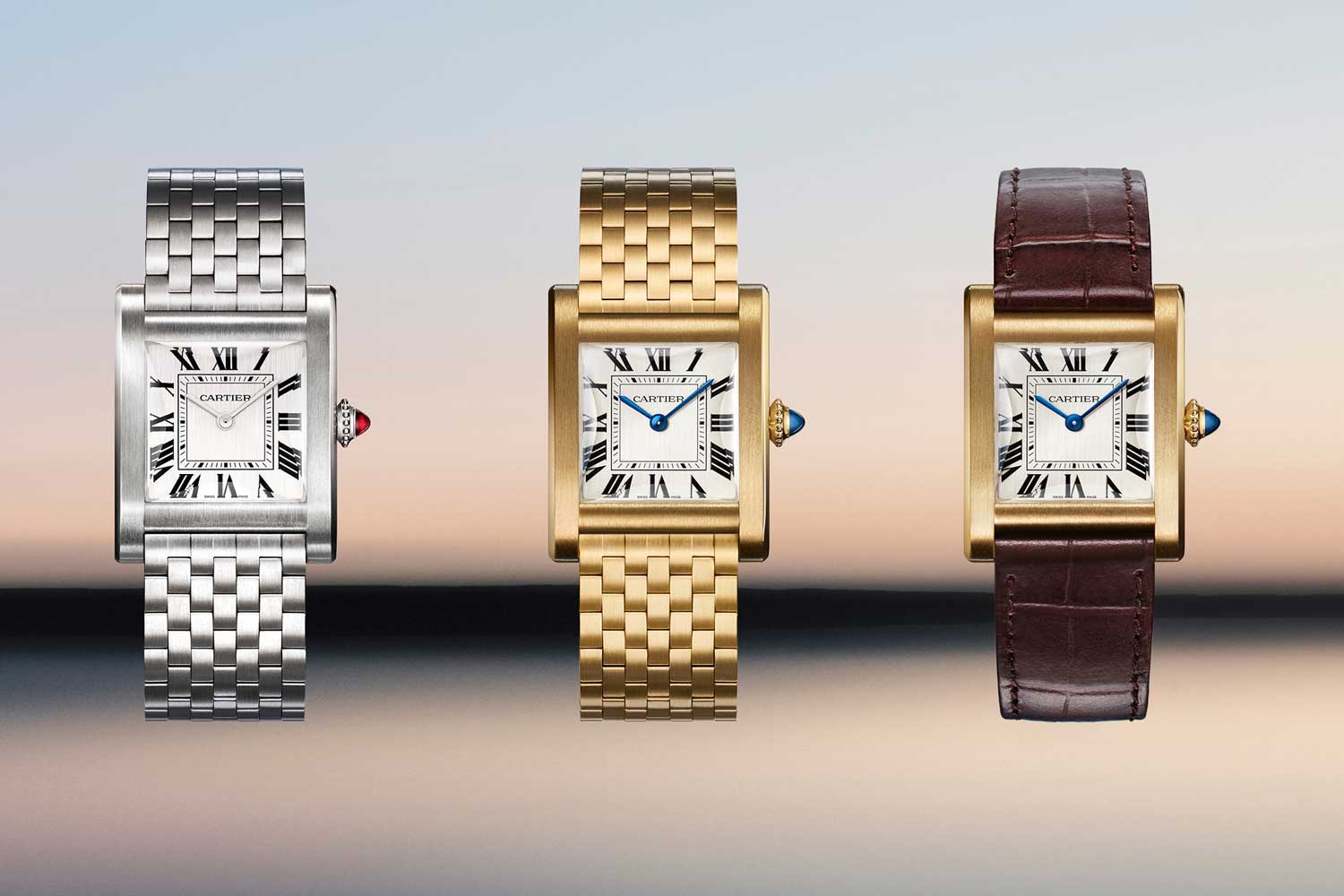
Cartier Privé Tank Normale
Cartier Privé Tank NormaleMovement: Manual-winding caliber 070 (standard), 38-hour power reserve; manual-winding caliber 9628 (skeleton), 36-hour power reserve
Functions: Hours and minutes (standard); hours, minutes, 24-hour day/night indicator (skeleton)
Case: 32.6mm x 25.7mm (standard), 35.2mm x 27.8mm (skeleton); 18K yellow gold or platinum
Strap: Alligator leather with matching metal buckle or matching metal bracelet (standard); alligator leather with matching metal buckle (skeleton)
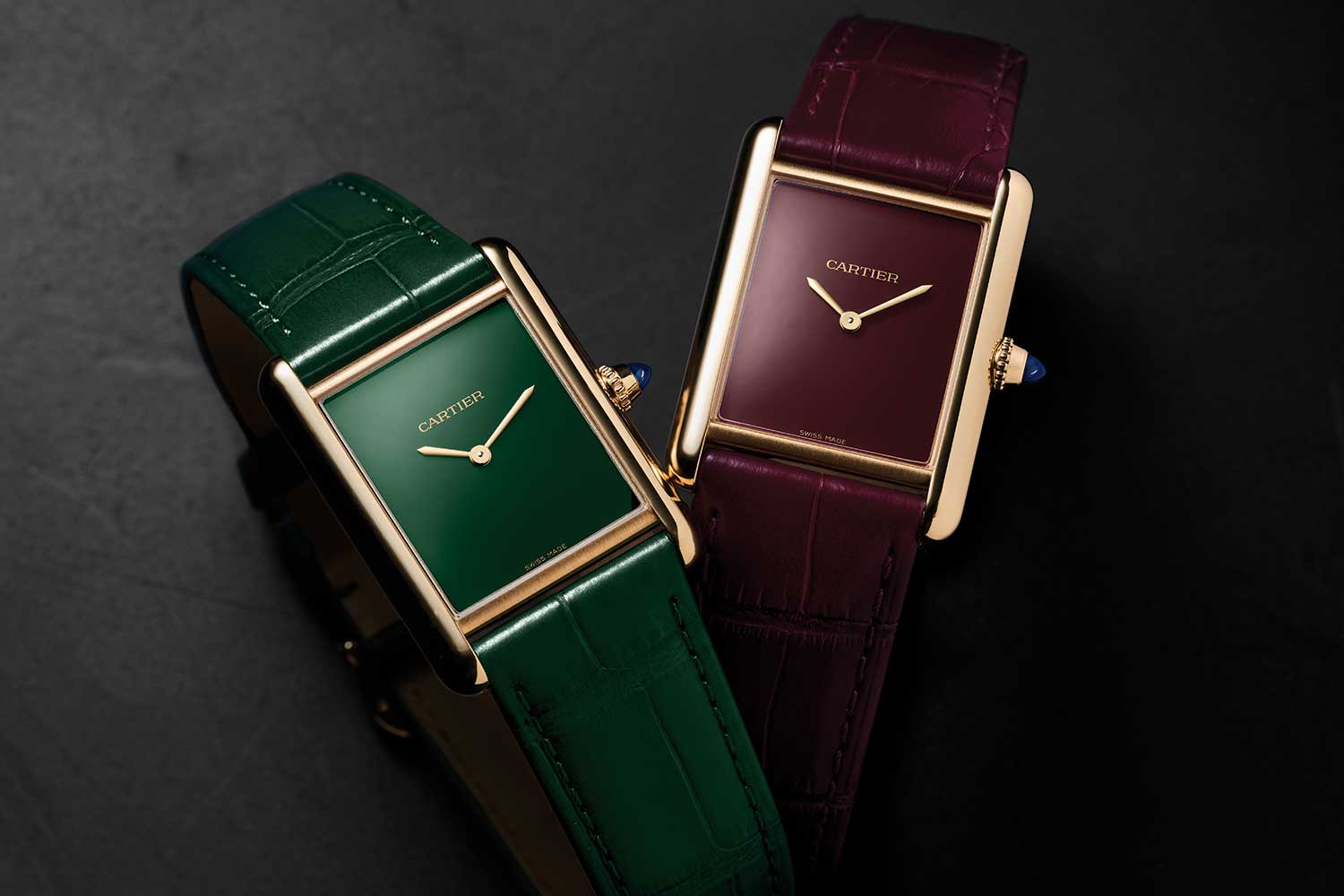
Tank Louis Cartier
The Tank Louis Cartier is, for many, the quintessential Tank, and for good reason. While the most classic expression of this famous watch involves blued hands, Roman numerals and a railroad track, it’s far from the only twist on this time-honored design. In recent years, we’ve seen a renewed interest and vigor in the line, thanks to a revival of pared- back, monochromatic models that pay tribute to the Tank Must models of the 1970s. Les Must de Cartier was what we would call a diffusion line today, offering everything from accessories to art de vivre and, of course, watches. These watches were known as the Cartier Tank Vermeil, a colorful, typically quartz-powered watch with a Tank Louis Cartier-style plated case. They were a hit at the time, and more recently they’ve served as inspiration for a new generation of colorful takes on the Tank Louis Cartier. A few years ago, Cartier released a trio of quartz Tanks with minimalist blue, green and burgundy dials, and they hit a nerve, demonstrating in a very real way that there was plenty of fun left in this iconic case shape.
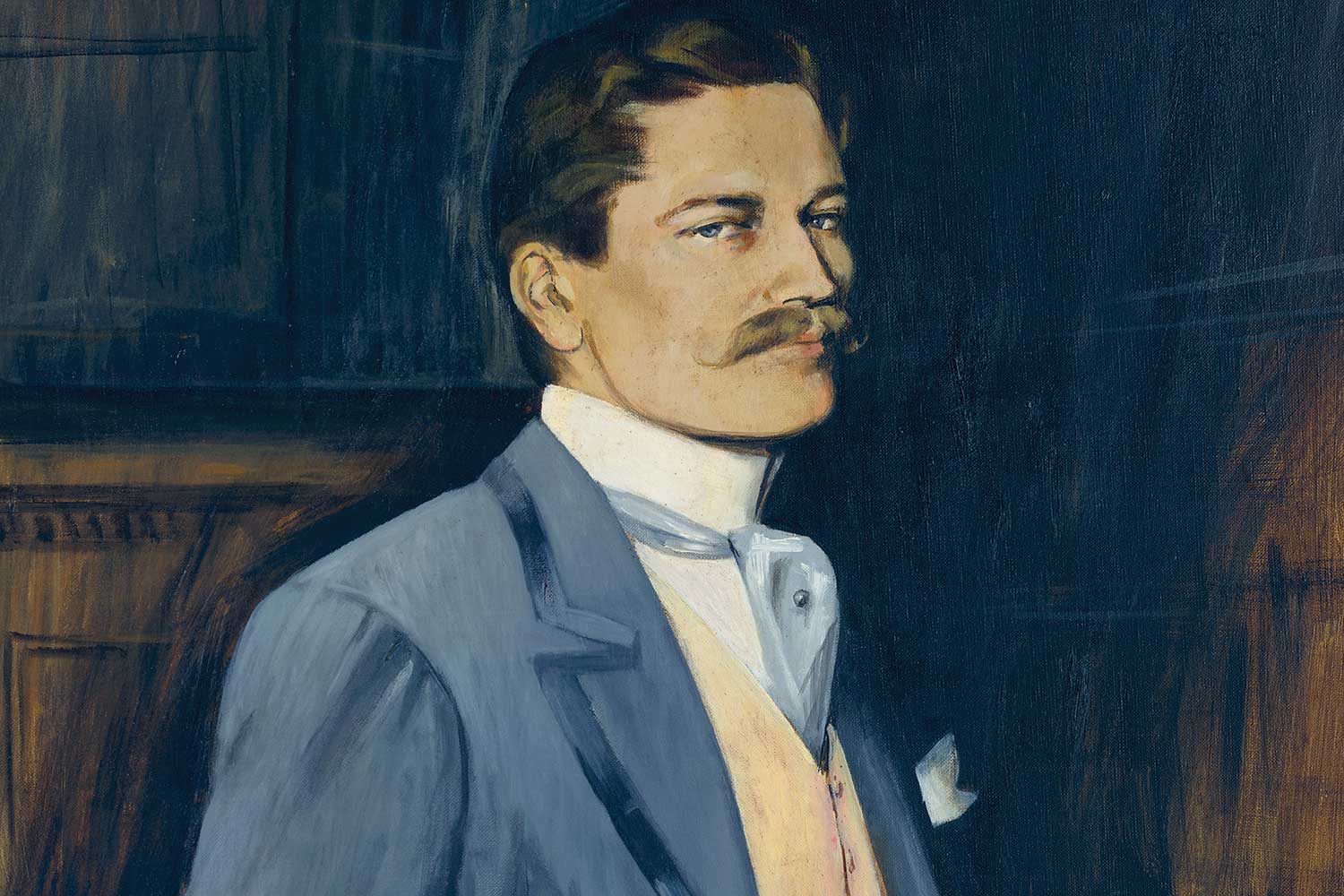
A portrait of Louis Cartier
This year, Cartier continued delivering on this theme with a series of sleek new precious-metal Tank Louis Cartier models. There were some dazzling pieces with ingenious tri- gold dials, as well as yellow gold models in bordeaux lacquer and green lacquer. The combination of a classically sized yellow gold case and mesmerizing, minimal colored dials on matching leather straps, is incredible. The effect is such that in the right setting, it appears that the glittering golden lines of the Tank Louis Cartier case are simply floating in the air. The Tank Louis Cartier bears his name for the purity and simplicity of the case. These watches take that a step further, removing any extraneous dial details, creating some of the most compelling examples of the Tank Louis Cartier we’ve seen in some time.
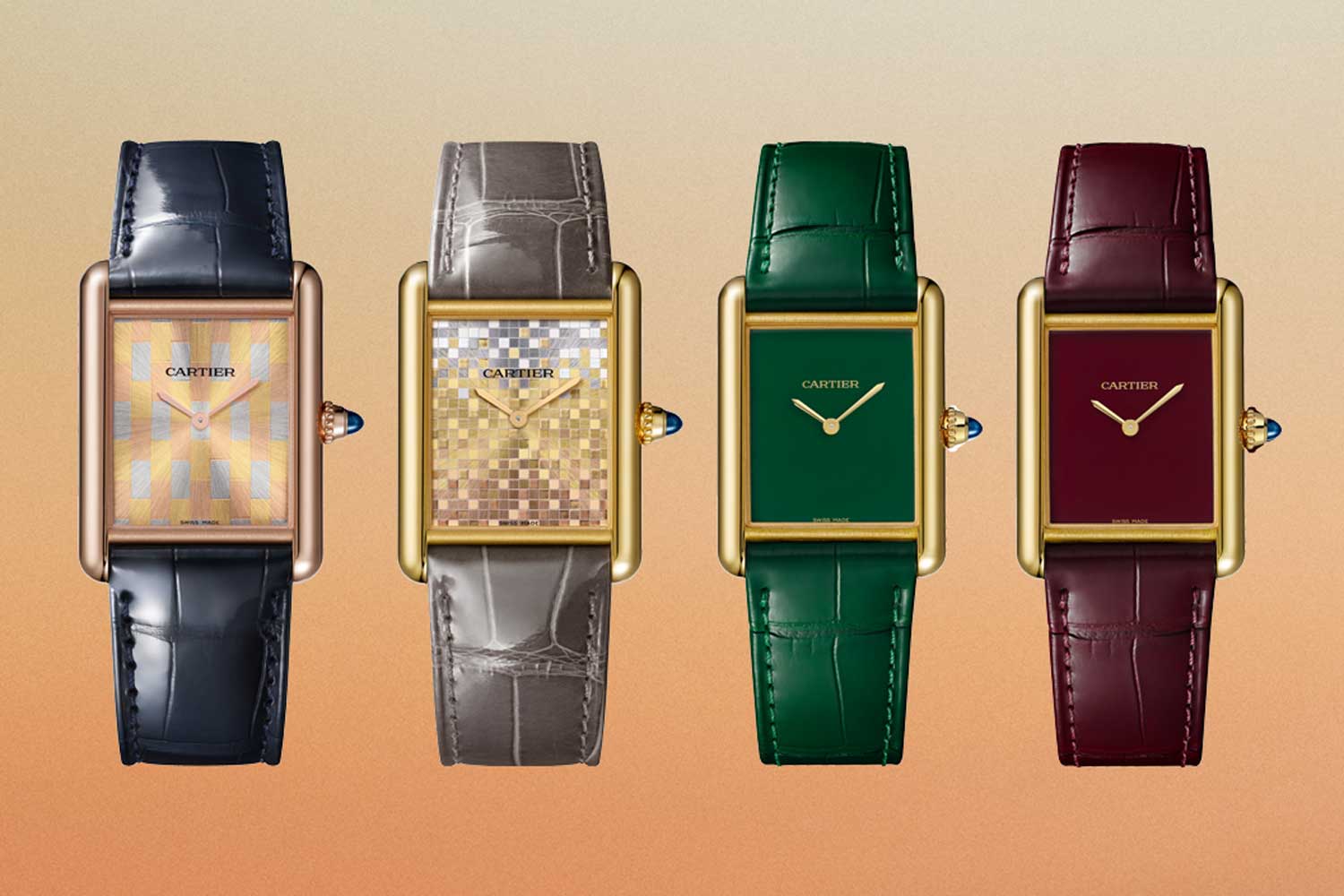
Tank Louis Cartier
Cartier Tank Louis CartierMovement: Manual-winding caliber 1917 MC; 38-hour power reserve
Functions: Hours and minutes
Case: 33.7mm x 25.5mm; yellow gold
Strap: Alligator leather
Once upon a time in Américaine
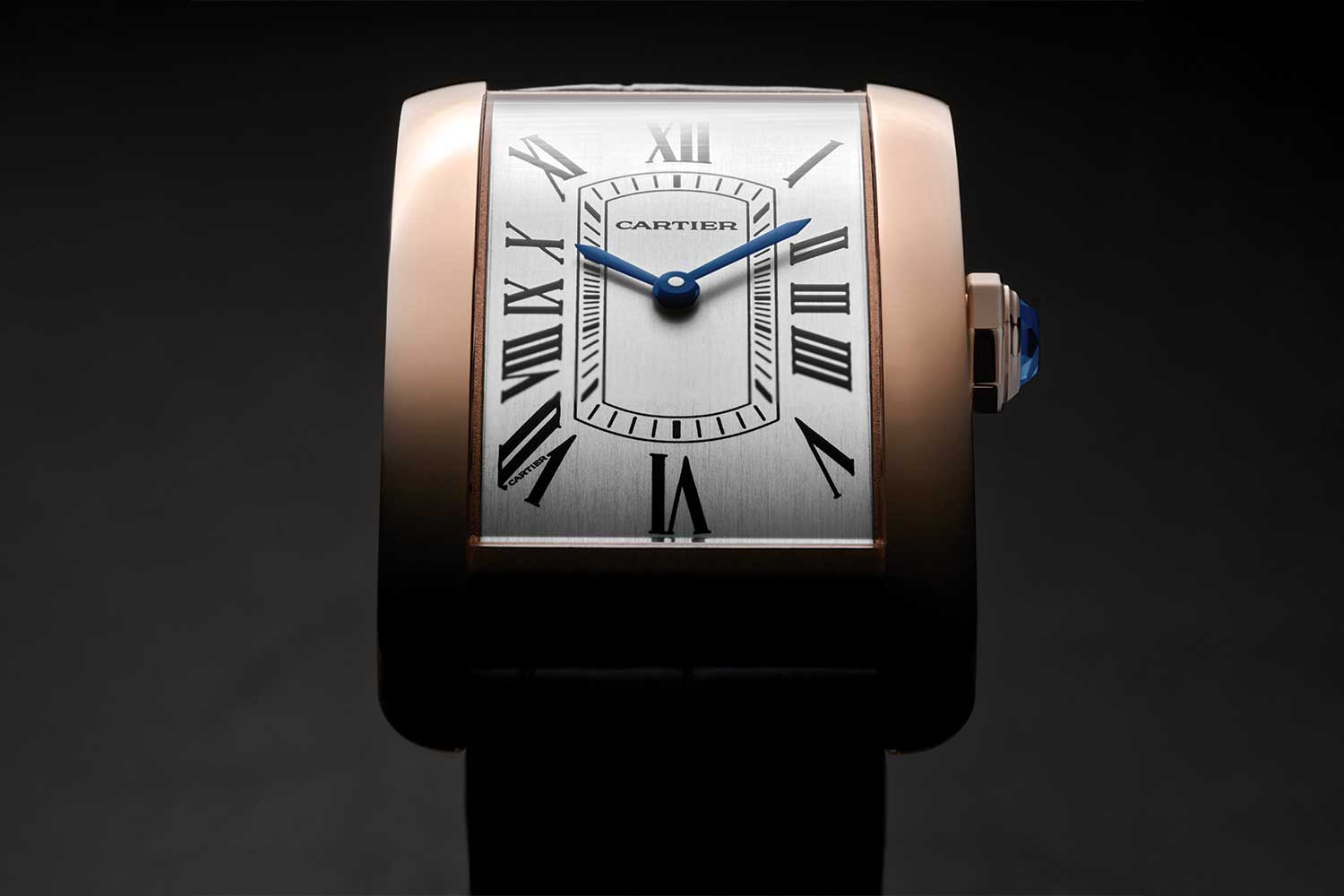
Tank Américaine
One of the more recent additions to the Cartier Tank family was the Tank Américaine. First designed in 1987, this watch is a curved take on the Tank, with broad brancards and a bold, perhaps even brash, energy. Pierre Rainero explains the genesis of this modern, masculine take on the Tank: “I remember it perfectly, because I was already at Cartier. The idea was to work on a bigger volume. Don’t forget that the Pasha was launched in 1985, so we have recent experience already with bigger sizes. A larger Tank allowed for explorations around a more readable dial, and playing with the notion of strength that was linked with the size of the watch. Of course, it had to be in line with what Tank was. There was a predecessor to the Tank Américaine, which was the Tank Cintrée, from the beginning of the 1920s. Naturally, watches from that time were not waterproof, and it was only a hand-wound mechanical movement. So we wanted all the qualities of a modern watch — it had to have water resistance and an automatic movement, at least for the bigger models. This meant we had to modify the case, as the automatic movement was not as small as a hand-wound movement. It was a lot of work to achieve a volume that was compatible with our new demands for a watch that was for modern times, but also faithful to our notion of elegance. That was the idea behind the Tank Américaine.”
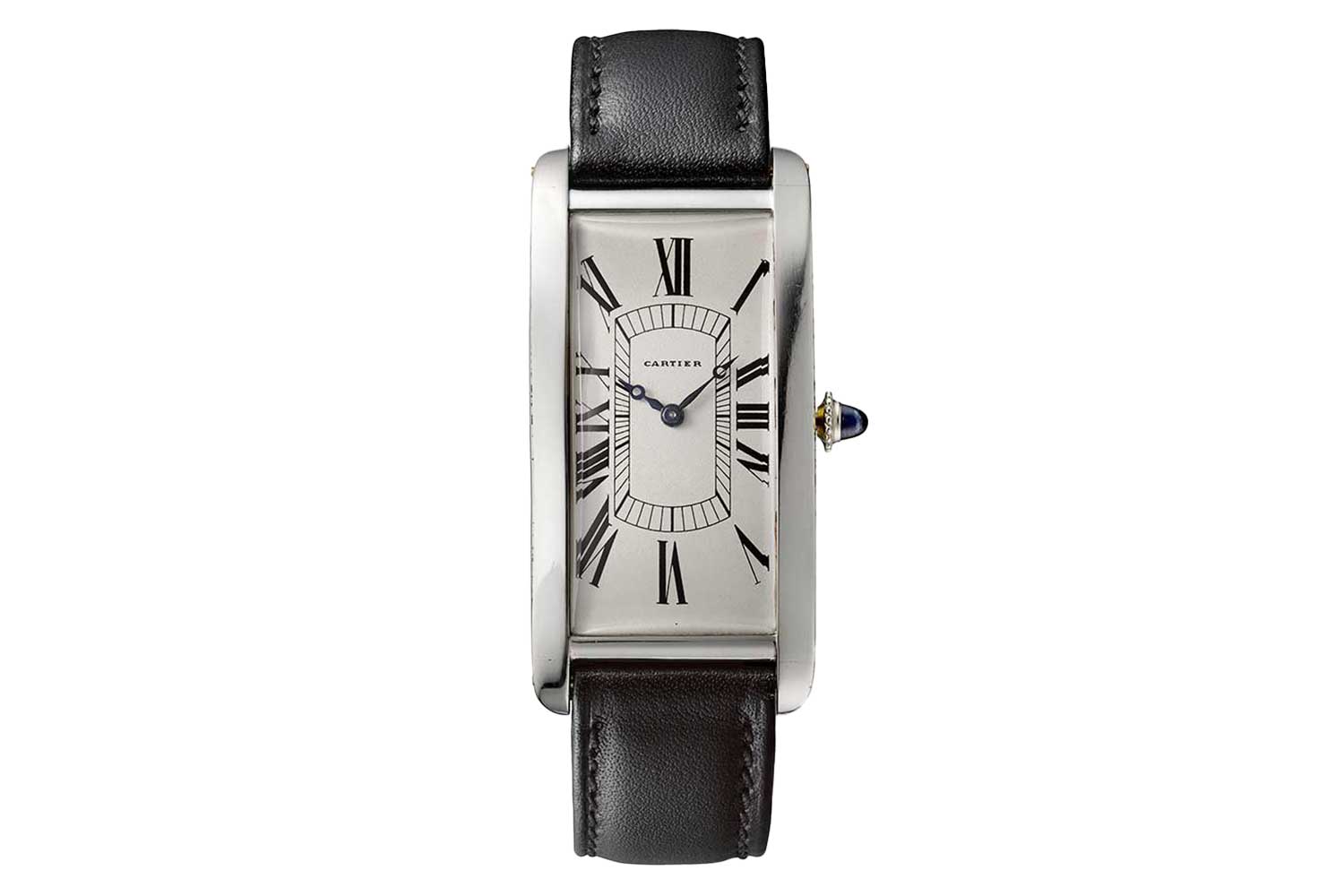
An exemplary Tank Cintrée Wristwatch from 1924 (Image: Cartier)
In the years since 1987, Cartier has produced many different interpretations of this larger Tank, continually evolving and iterating on the familiar lines. The most recent update sees the Tank Américaine once again revisit the fundamentals, the spirit of “nothing too much”. The 2023 Tank Américaine comes in three sizes — mini, small and large — and with pink gold and steel cases. The smaller versions can come with optional diamonds and bracelet options, and, should be looking for a truly extravagant option, there’s a mini white gold model on bracelet that’s fully set with stones. These smaller sizes offer an elegance all their own, but it’s the larger model, with its automatic 1899 MC caliber that is in the spirit of the ’87 original. The large size is quite substantial too, measuring 44.4mm from top to bottom and 24.4mm across. Having said that, it’s actually slimmer than its predecessor, at only 8.6mm tall. This has a significant impact on the wrist, and ensures both presence and wearability. Beyond that, there’s been plenty of other small, subtle tweaks: sleeker lines, better ergonomics, the shaving of a fraction of a millimeter here and there. It might not seem like a lot, but the overall effect, in person and on the wrist, is significant. These changes are all there to accentuate the curve of the watch, the feeling of flow and drape around the wrist that is so central to the identity of this watch. It’s an impressive and cohesive update, and one that, like so many of Cartier’s creations, feels both contemporary and classic.
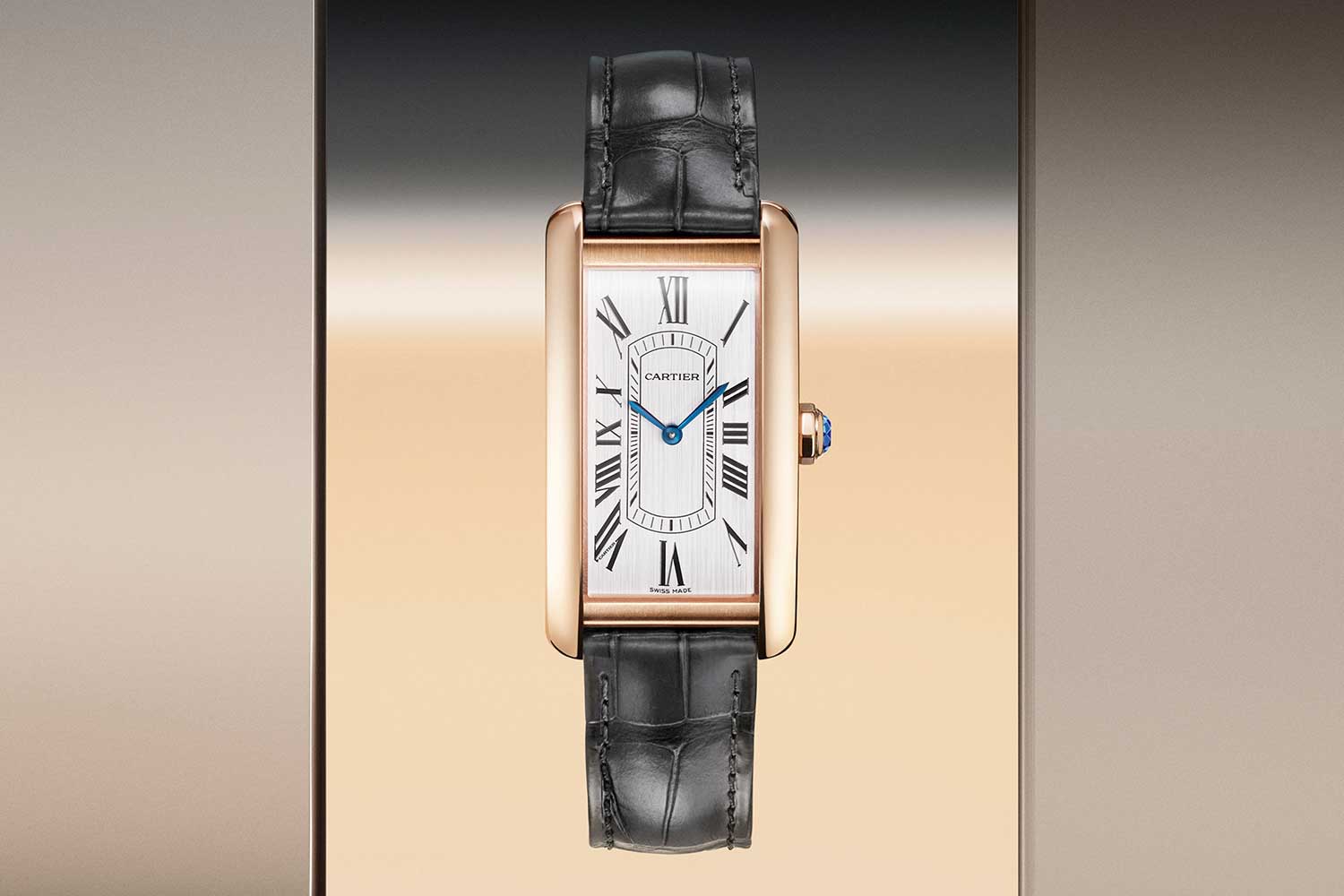
Tank Américaine
One aspect of the identity of the Américaine that has always been intriguing is the name itself. In the 1980s, the Américaine was, essentially, a new design, albeit one heavily informed by the Maison’s significant archive. So, what makes the Américaine American? Rainero explains: “Well, there’s the saying, ‘everything is bigger in America’, which is fitting. Also, don’t forget the popularity of the Tank started at the First World War with General John J. Pershing wearing a Cartier Tank. That was a link to this story from the very beginning of Tank, so that was the idea at the beginning, as well as to pay tribute to our American clientele.”
Cartier Tank AméricaineMovement: Quartz (mini and small); self-winding caliber 1899 MC (large)
Functions: Hours and minutes
Case: 28mm x 15.2mm x 6.5mm (mini); 35.4mm x 19.4mm x 6.8mm (small); 44.4mm x 24.4mm x 8.6mm (large); stainless steel and rose gold; mini also offered in white gold; diamond options available for mini and small models
Strap: Alligator strap; mini and small also offered with bracelets
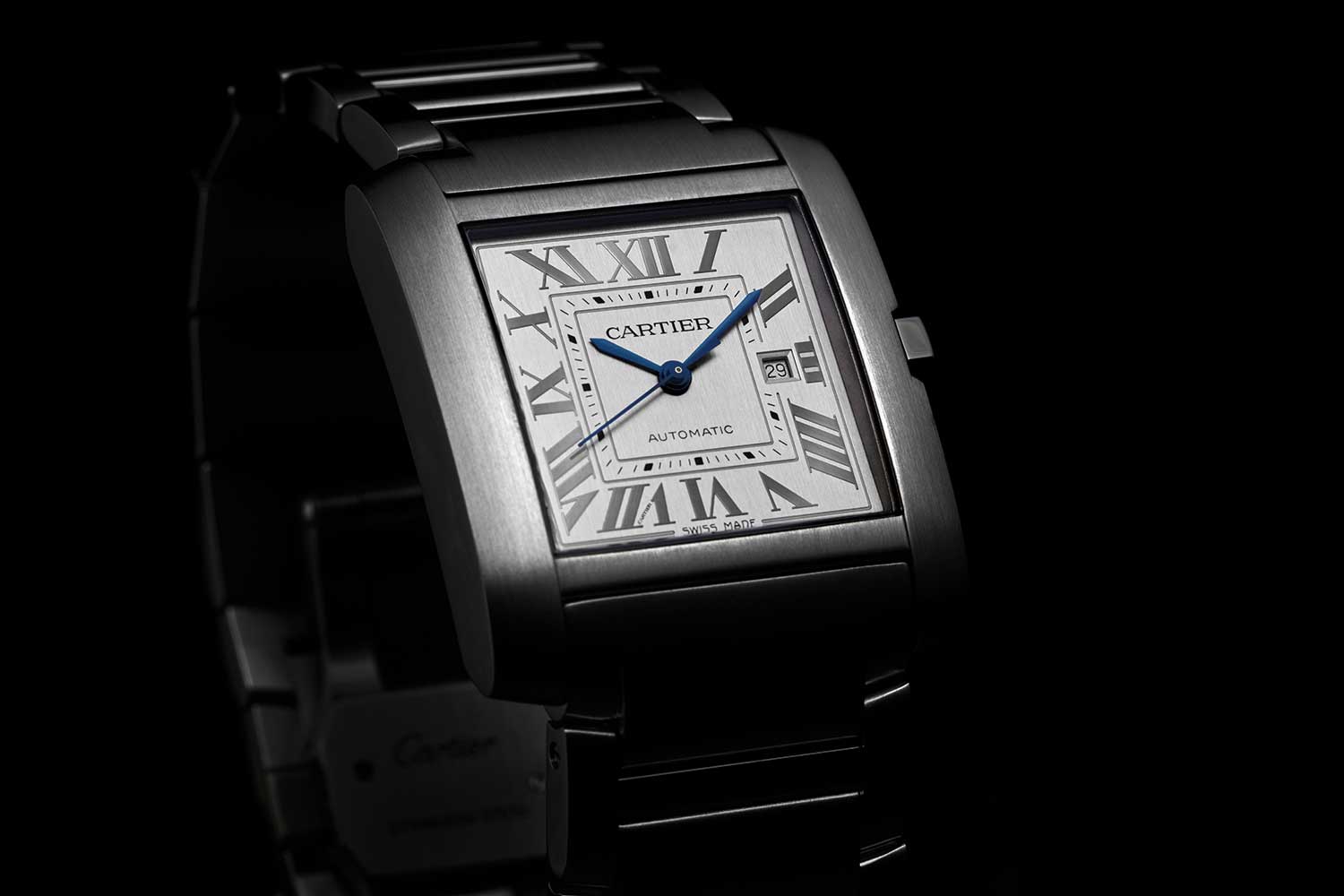
The Tank Française in steel
Another more recent addition to the extended Tank family was the Française, which burst onto the scene back in 1996. Unsurprisingly, it was a hit. Pierre Rainero explains the concept behind this angular option: “It was the idea of a perception of a very well-balanced square. The square is very strong in French culture. When we first introduced it in 1996, I remember that idea of the square in French urbanism or architecture was a point of reference. The Tank Française also takes the idea of a Tank Normale, that square dial in a rectangular case. So, that’s how it was born, in a very natural way.”
If the genesis of this design was rooted in Cartier’s own history and French civic culture, the reception to this model, according to Rainero, had help from a decidedly non-French fan. “The Tank Française was well received, and of all the models, there were two in particular that were the center of attention. A small model in gold with a gold bracelet that was a hit, I think, for many women. The fact that Lady Diana [wore one], for instance, was a very good point for that model. Also, the automatic model in steel, or in steel and gold, was very well received especially for men at the time.”
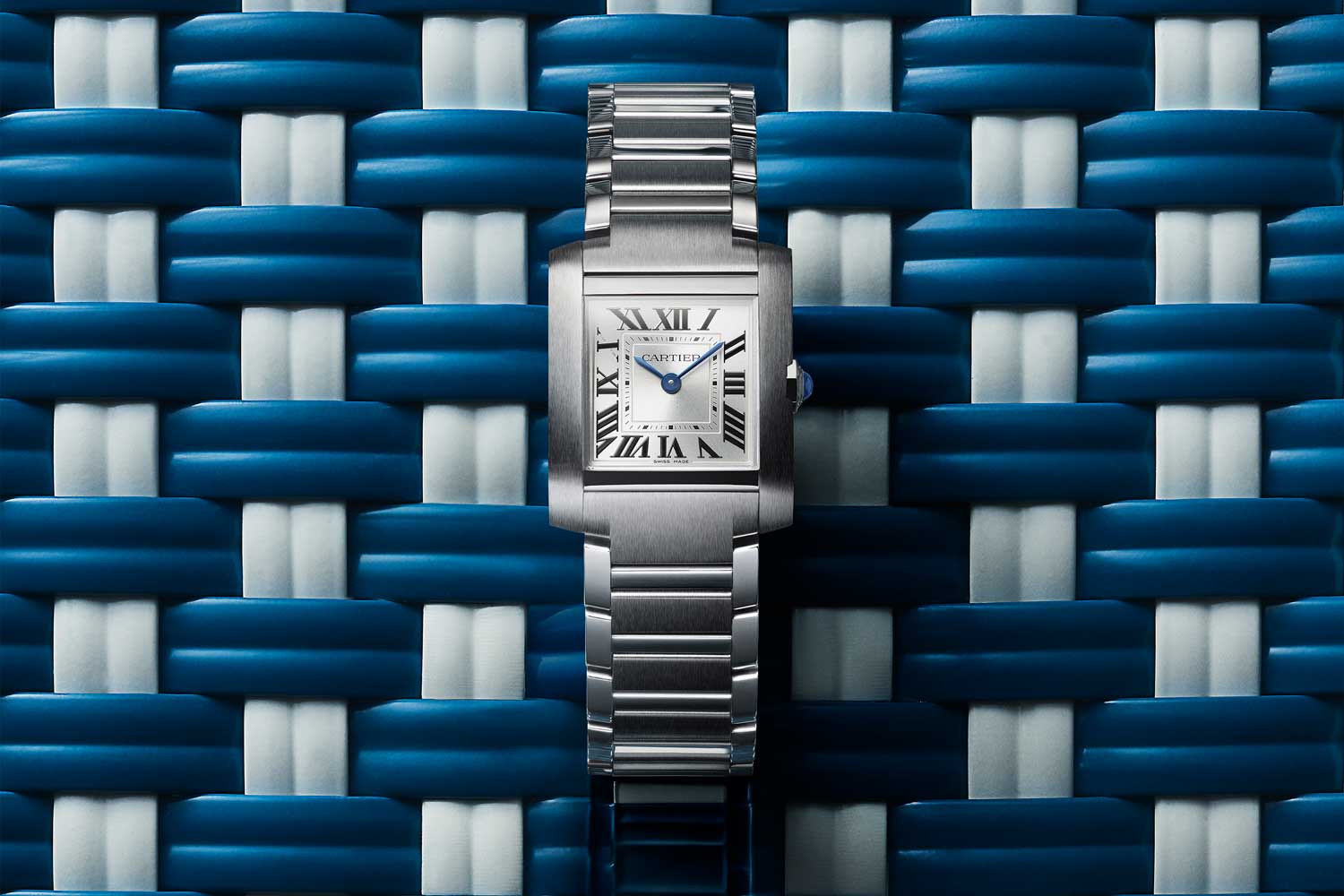
Cartier Tank Française
For many, that first generation of Tank Française will forever be associated with Lady Diana, so you can’t help but wonder what the most recent update, released earlier this year, will be famous for. Staying close to the spirit of the original, these Tanks are offered in steel or yellow gold, and feature a range of incremental design improvements intended to make this latest Tank Française a better fit on the wrist, and more robust. Of course, it’s only fitting that Cartier enlisted the help of renowned actor Rami Malek, along with Catherine Deneuve, legend of the French New Wave, to tell the story of the Tank Française.
Cartier Tank FrançaiseMovement: Quartz (small and medium); self-winding caliber 1853 (large), 37-hour power reserve
Functions: Hours and minutes (small and medium); hours, minutes, seconds and date (large)
Case: 25.7mm x 21.2mm x 6.70mm (small); 32mm x 27mm x 7.08mm (medium); 36.7mm x 30.5mm x 10.12mm (large); steel or yellow gold, with diamond options (small and medium); steel (large); water resistant to 30m
Strap: Matching steel or yellow gold bracelet
Cartier and the culture of design
Though the original design of the Cartier Tank is incredibly simple, it’s also far from prescriptive, as you can see from the numerous design variations and iterations that Cartier has conjured up over the years. The Américaine, the Française and all the other variants of this idealized rectangle are all remarkably different, while still holding true to the core tenets of the Tank design language. This, as we have said, is the mark of a design that defines a genre and has a cultural impact that goes well beyond the world of fine timekeeping.
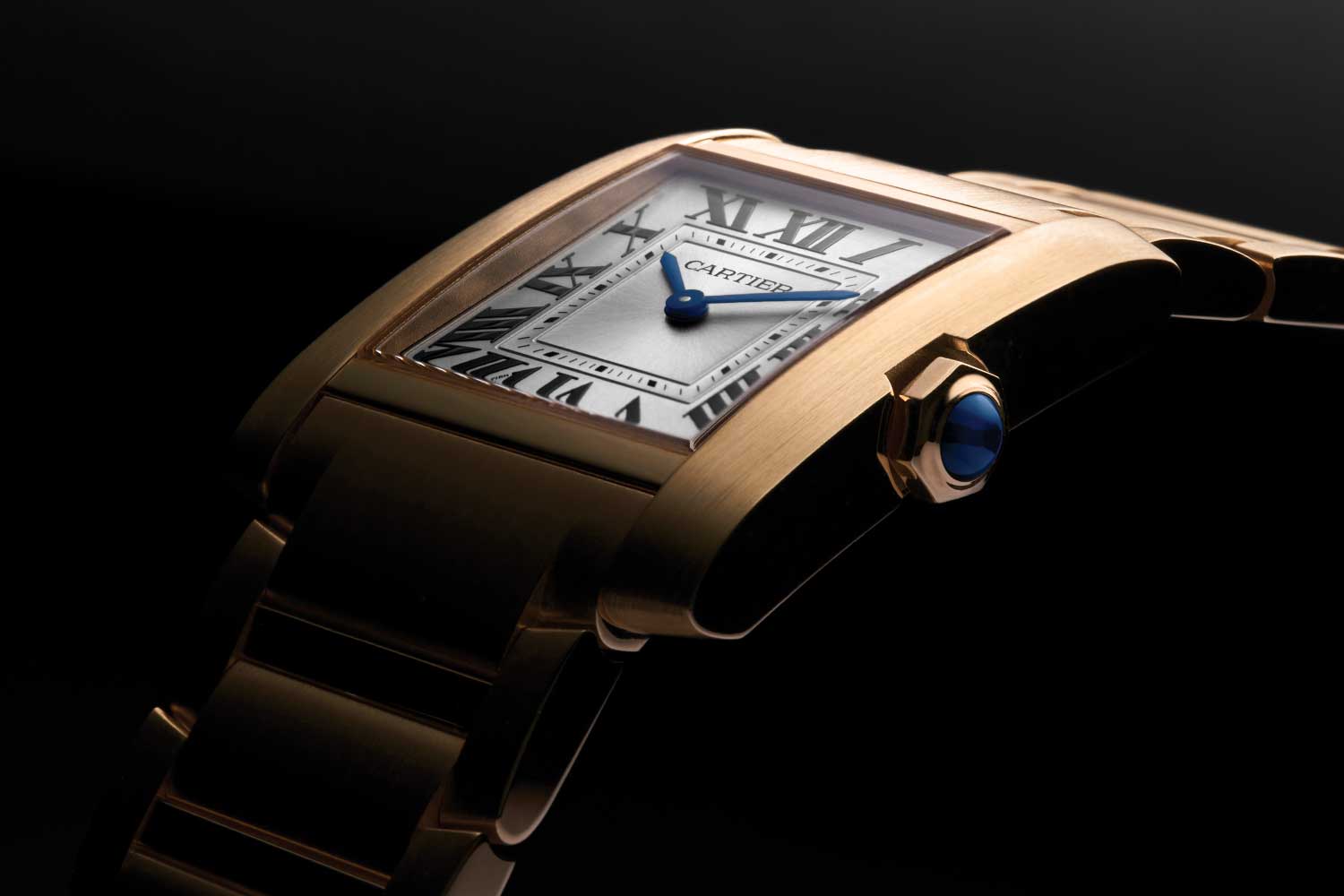
The clear geometry of the Tank Française are accentuated in gold
The legacy of the Cartier Tank also brings in a unique perspective when it comes to creating new versions. Namely, Cartier doesn’t follow trends, at least not trends when it comes to watches. Pierre Rainero explains, “At Cartier, the idea of taking into account what is happening in the ‘market’ is not a strong preoccupation because our culture — in terms of product design and creation — is very specific. When we decide to work on a new design, it’s more a question of feeling rather than calculation or following a trend. In fact, Cartier is in such a specific position in watchmaking because of our very different design. We are used to following our own path. For instance, the Pasha. We decided to launch it in 1985, and of course, the process started earlier; the so-called trend for big watches did not exist yet, so it’s not that we were following an existing trend.”
Of course, Rainero is quick to assert that while Cartier’s watch design is not the result of painstaking market analysis, it does exist within the real world and acts accordingly. “At Cartier, we’re not immune to what’s going on around us. So maybe there’s a shared global taste, so influence can come from outside — not necessarily from watchmaking, but from global culture. We are part of a global vision that is shared by many other people at the same time.”
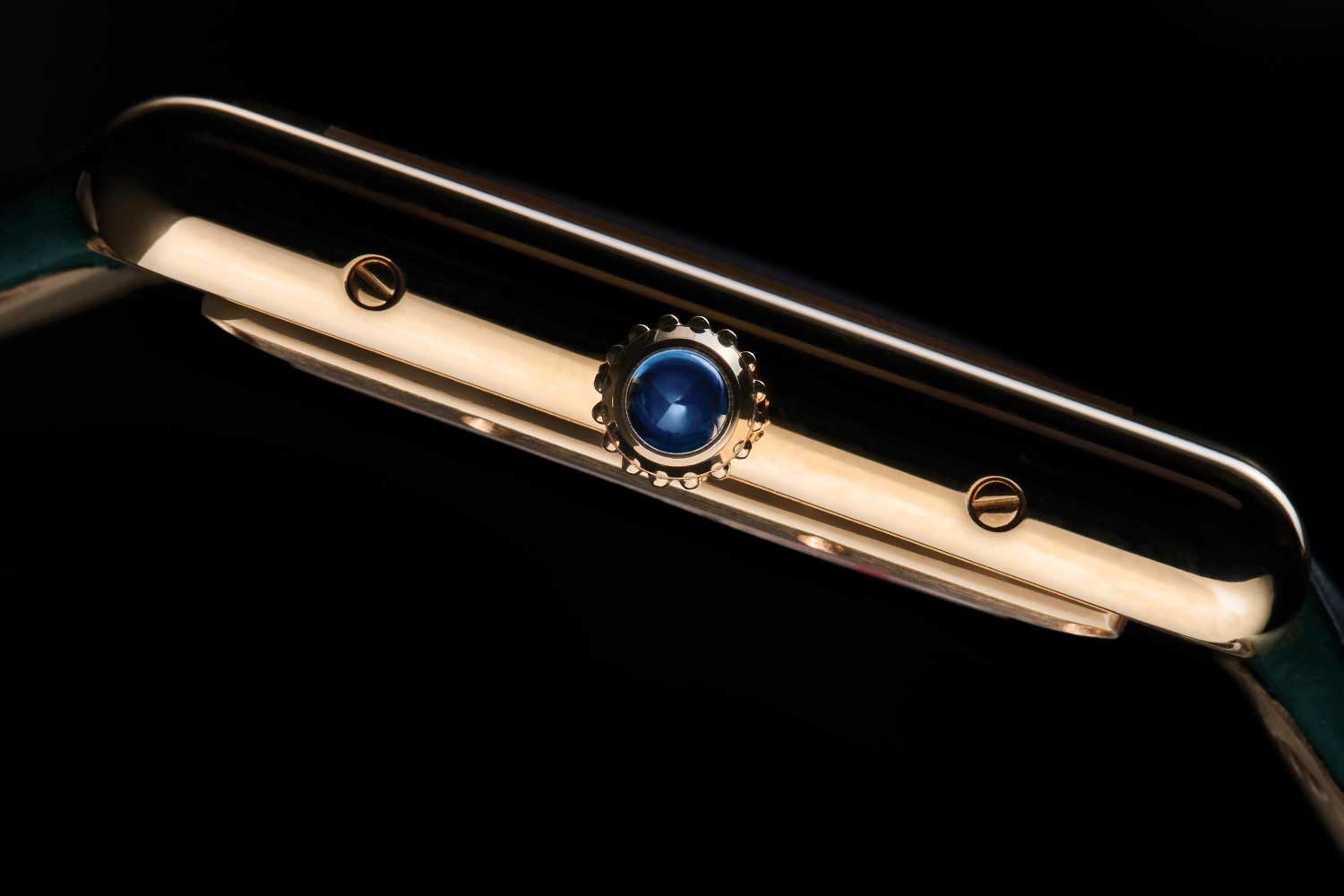
Even the clean lines of the flank embody Cartier’s preoccupation with simplicity
Naturally, having the incumbent position when it comes to elegance timekeeping helps, especially when the pendulum of taste swings from large back to more manageable sizes. “Recently, there’s been incredibly strong interest in our creations in the more traditional sizes. For example, look at this year, with the Tank Normale. Again, the eyes of the public are turning to the elegance of a smaller watch. I don’t know if Cartier creates that interest or if the wider context is once again ready to accept those shapes. It’s that old saying, what came first, the chicken or the egg?”
One aspect of Cartier’s long history that is quite unique is the three founding boutiques that play a huge role in the history and development of the brand. Located in Paris, London and New York, Cartier calls them “The Temples”. For Rainero, this shared history and divided geography have been formative to the Maison’s evolving identity.
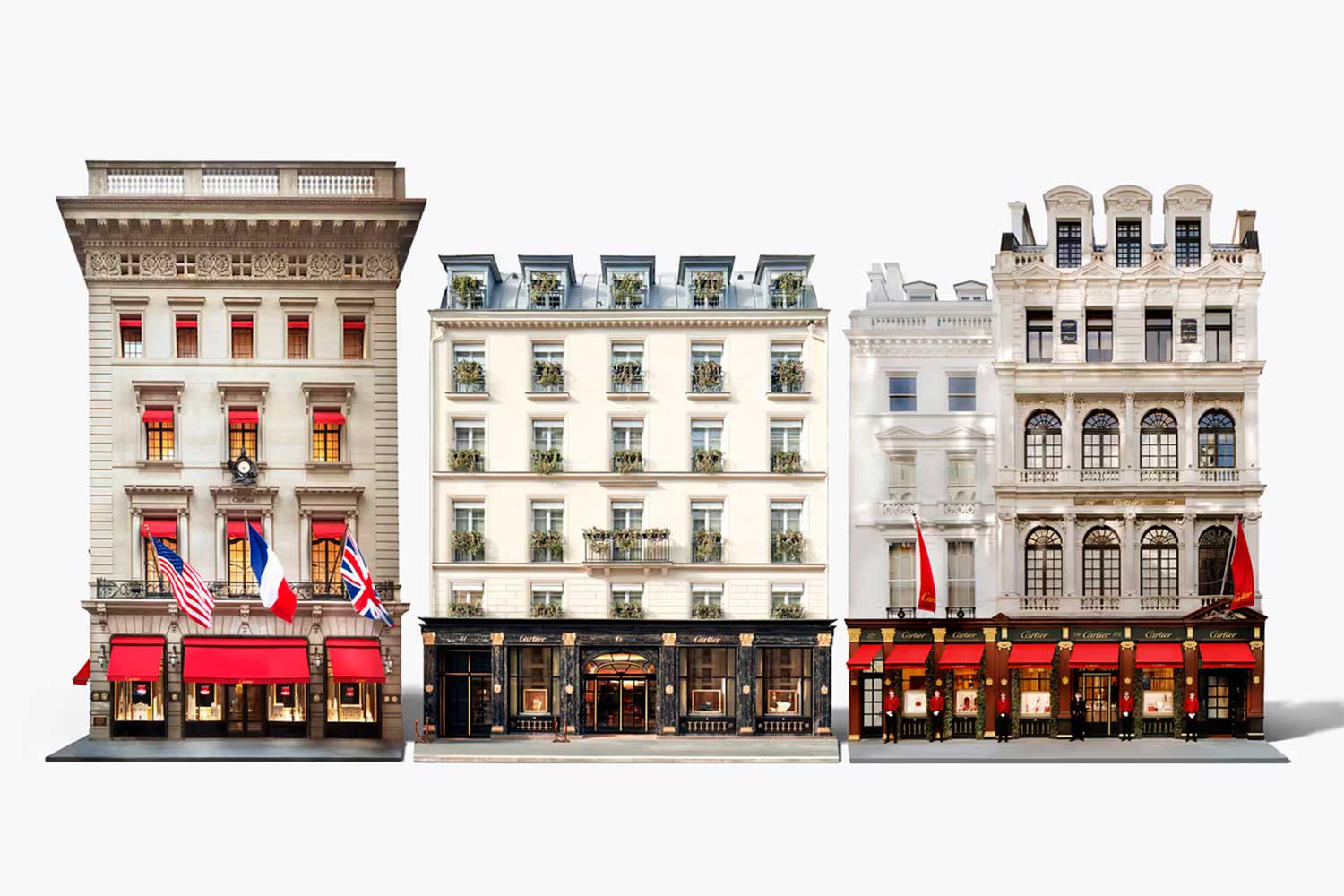
Paris, London, New York. Three founding boutiques. Three legendary locations that saw Cartier open up to the world and lay the foundations for what was to become one of the finest adventures of the century (Image: Cartier)
“When you look at the production of Cartier watches, it’s very interesting to see variations that took place in New York or London. As you know, since the beginning, the design for watchmaking was born in Paris, and it was a success in all locations. For practical reasons, we sent movements on the one hand and the cases on the other hand to our London and New York locations.” However, what began as a practicality of business in a pre-globalized time had some unexpected benefits.
“At the time, it gave freedom for the London staff and the New York staff to create their own cases, and with a movement that we’ve sent from Paris, and we see some creations in New York and in London. The most well- known example is the period of the late ’60s and early ’70s in London. It’s interesting to see how there was a sort of playfulness in London on the basis of the shapes that were created in Paris. It was like Cartier was playing with its own iconic designs: that was how the Crash watch was born — a very pure oval shape, but crashed. That was how the Pebble was born, the square dial, placed in a lozenge position within a circle. Someone would play with the aesthetic vocabulary of Cartier watches to propose something different. Many observers made a link between that period in London, famous for its culture and activity at the time, and the spirit that took place at Cartier at that time. In America, there were variations on some models, but mainly with our jewelry watches. These three locations helped build an entire part of our own culture of design because, of course, the London designs are part of our contemporary culture today, and probably it added that notion of playfulness with shapes.”
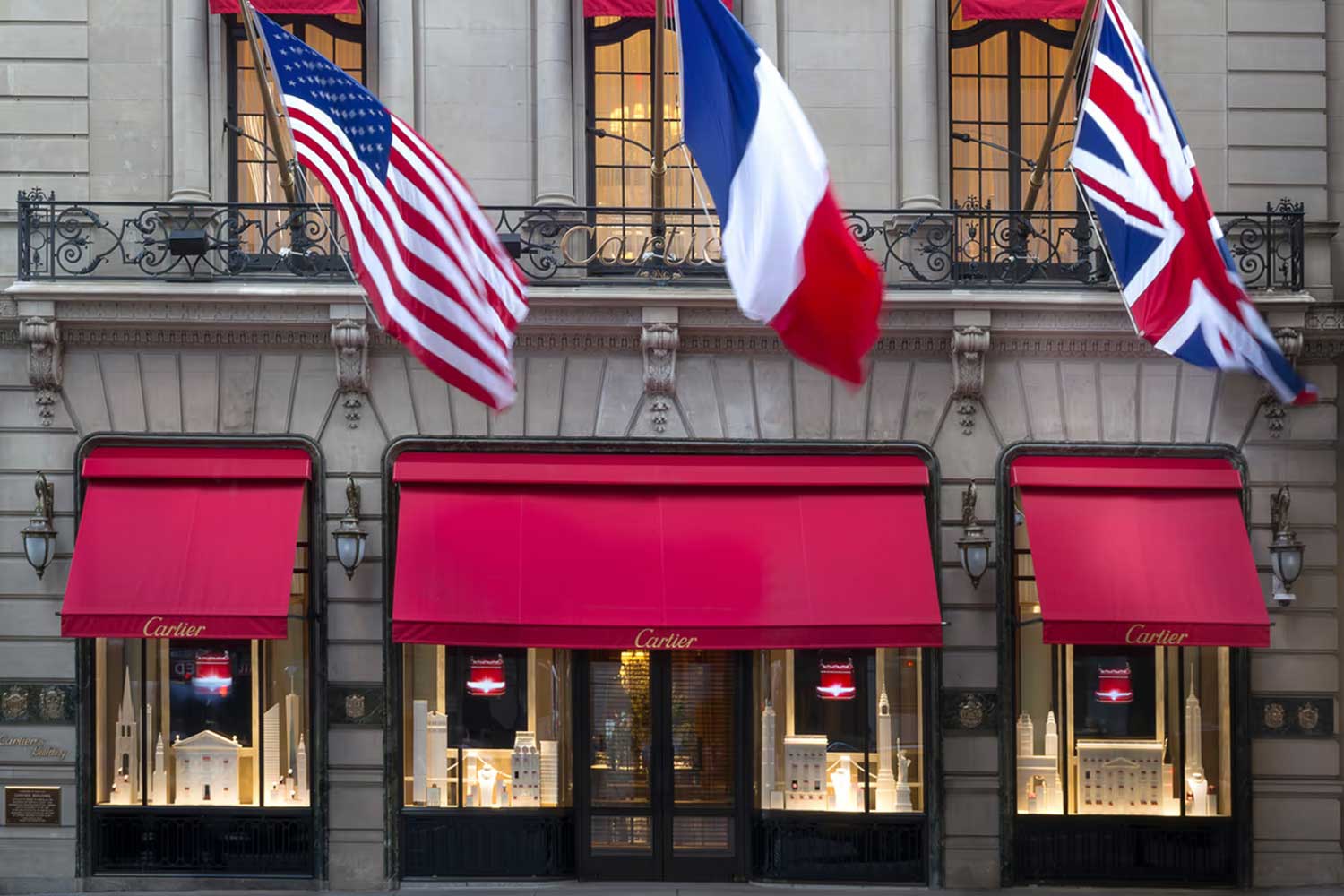
The Mansion (Image: Cartier)
That was then, and this is now. Today the world is a very different place, and infinitely more interconnected. This begs the question: can the sort of organically emerging regional design language that emerged within Cartier’s London location exist in a more corporate era? According to Rainero, the Maison has changed, while still celebrating that core identity: “The world is different now. Our company is centralized because we don’t have the same problems that existed then, in terms of customs, transportation or whatever else, so it’s easier. In terms of design, everything is centralized in Paris, but thanks to different factors, including the history that we [have] in New York and London, [it has] helped to mature our way of looking at new designs. On top of that, the nationality of our designers is important. We don’t only have French designers. There’s a mix of cultures at the origin of a design. I think we always have an eye on what is going on everywhere. Beyond that, access is easier. Even without looking actively, everyone is exposed to what’s going on in terms of art, architecture and day-to-day life, everywhere in the world. There’s a tradition at Cartier to be curious about what’s going on outside Cartier and outside France. We have that natural tendency to look at what’s going on within the culture of design. We are not influenced in our own fields of jewelry or watchmaking; we’re influenced by other artistic expressions. Finally, we always take into account the final destination of our creations. It’s important to understand how people will live with these objects. This is key.”
The Cartier Tank is far from an accidental icon. Its success is due in no small part to the continual consideration and care that Cartier has put into shepherding its legacy through the generations that ensure it is as relevant today as it was 50 or 100 years ago.
The culture of Cartier in Australia
The relationship between Cartier and Australia dates back a surprisingly long time, with opera singer Dame Nellie Melba becoming a loyal client of the Maison back in 1901, and kangaroos showing up as ornamental objects in 1905. However, it took a little longer for Cartier’s presence to be felt in Australia — the Maison exhibited high jewelry in Melbourne in 1959, and in 1975, the first Cartier point of sale opened in Sydney. But, as Sydney’s new flagship boutique demonstrates, Australia has been making up for lost time, and Cartier is embracing the arts, culture and people of Australia.
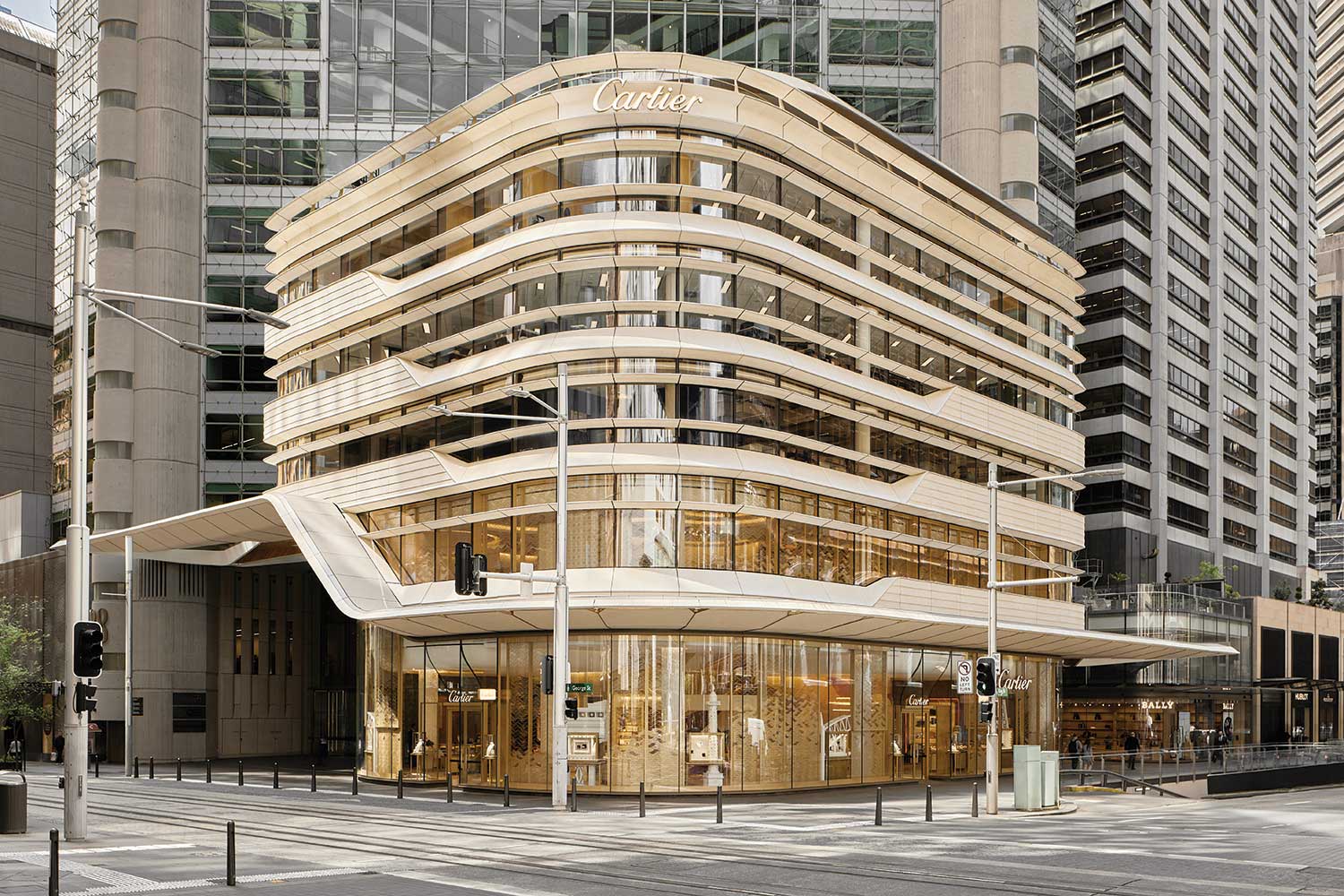
Images of Cartier’s 388 George Street location in Sydney
Located at 388 George Street, the curving, sinuous facade of the boutique glistens in champagne hues, much like the precious jewels that can be found within. While the overall design and vision for this space have been overseen by the Parisian firm Moinard Bétaille, who have been working with Cartier to express their identity for 20 years. The 388 George Street location is an exuberant celebration of Australian artistic expression and French design, which is perfectly in keeping with Cartier’s values of preserving and celebrating artistic crafts from across the globe. It’s hard to miss the crystal quartz chandeliers, designed by Melbourne industrial designer Christopher Boots. Throughout the space, there are recurring custom patina finishes — with eucalyptus-inspired motifs — designed and executed by Australian creative studio Di Emme. Carpets, couches and side tables are designed and made by local businesses too. But one of the most stunning features (and in a space like this, decked out in hand-painted silks, that’s a big call), is the large weaving wall, created by Bula’bula artists from a community-owned indigenous arts center in Ramingining, in east Arnhem Land. This woven textile technique has been passed down as storytelling for over 60,000 years and is created from hand-dyed pandanus leaves. This work, which is the largest created by Bula’bula artists, required the work of five master weavers and assistance from an additional eight weavers. It’s remarkable that different families have distinct weaving techniques, allowing for individual identity within the larger work.
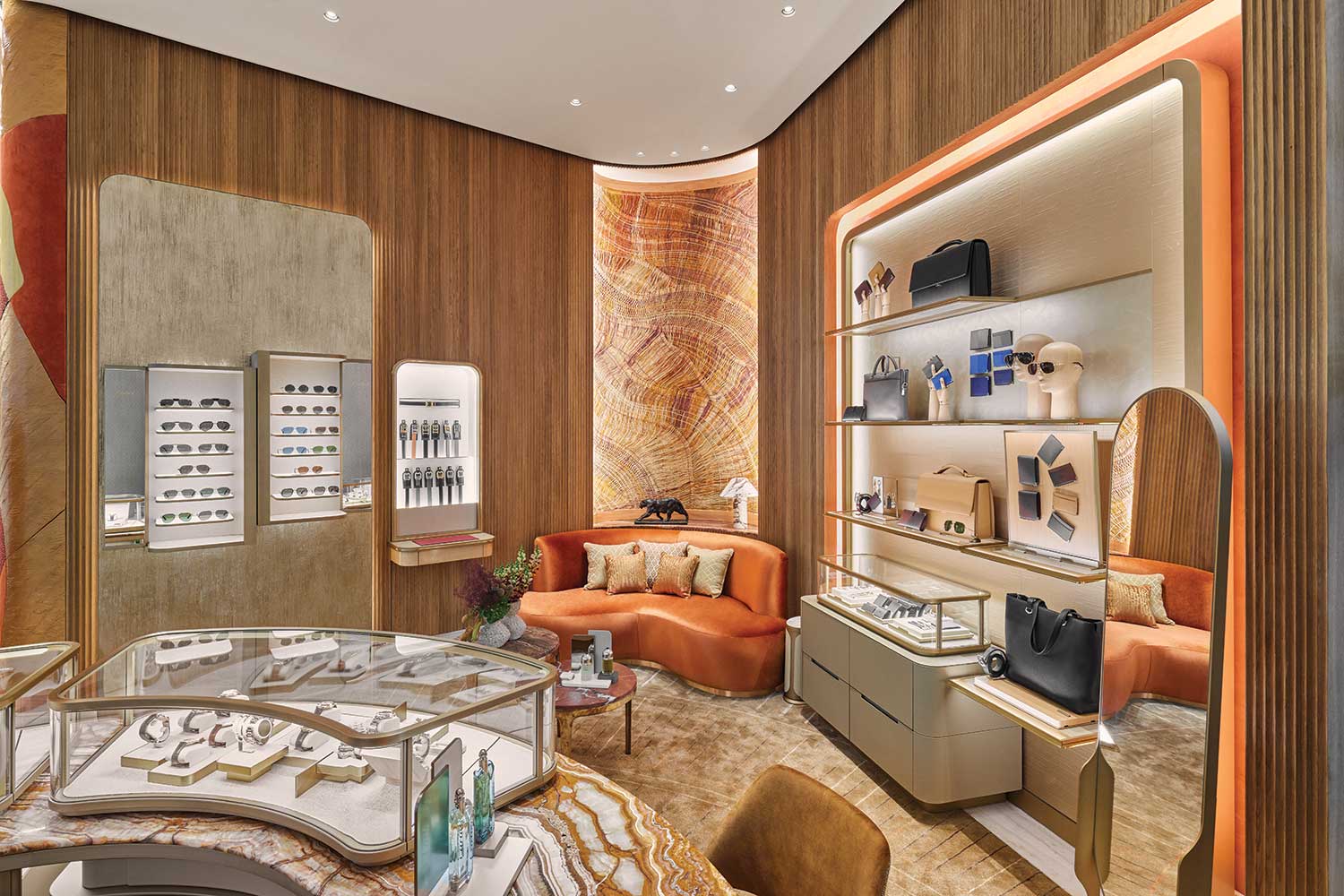
Images of Cartier’s 388 George Street location in Sydney
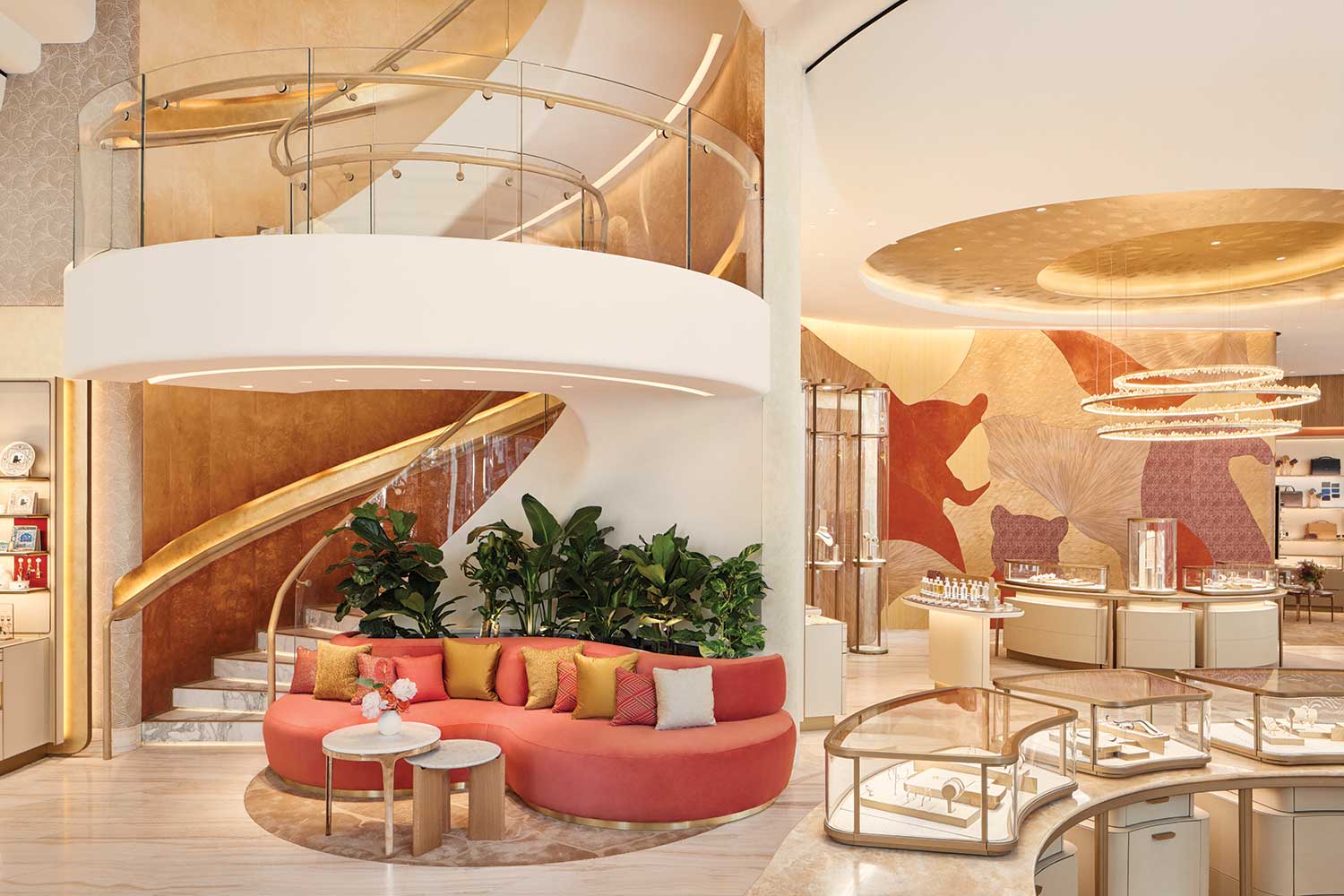
Images of Cartier’s 388 George Street location in Sydney
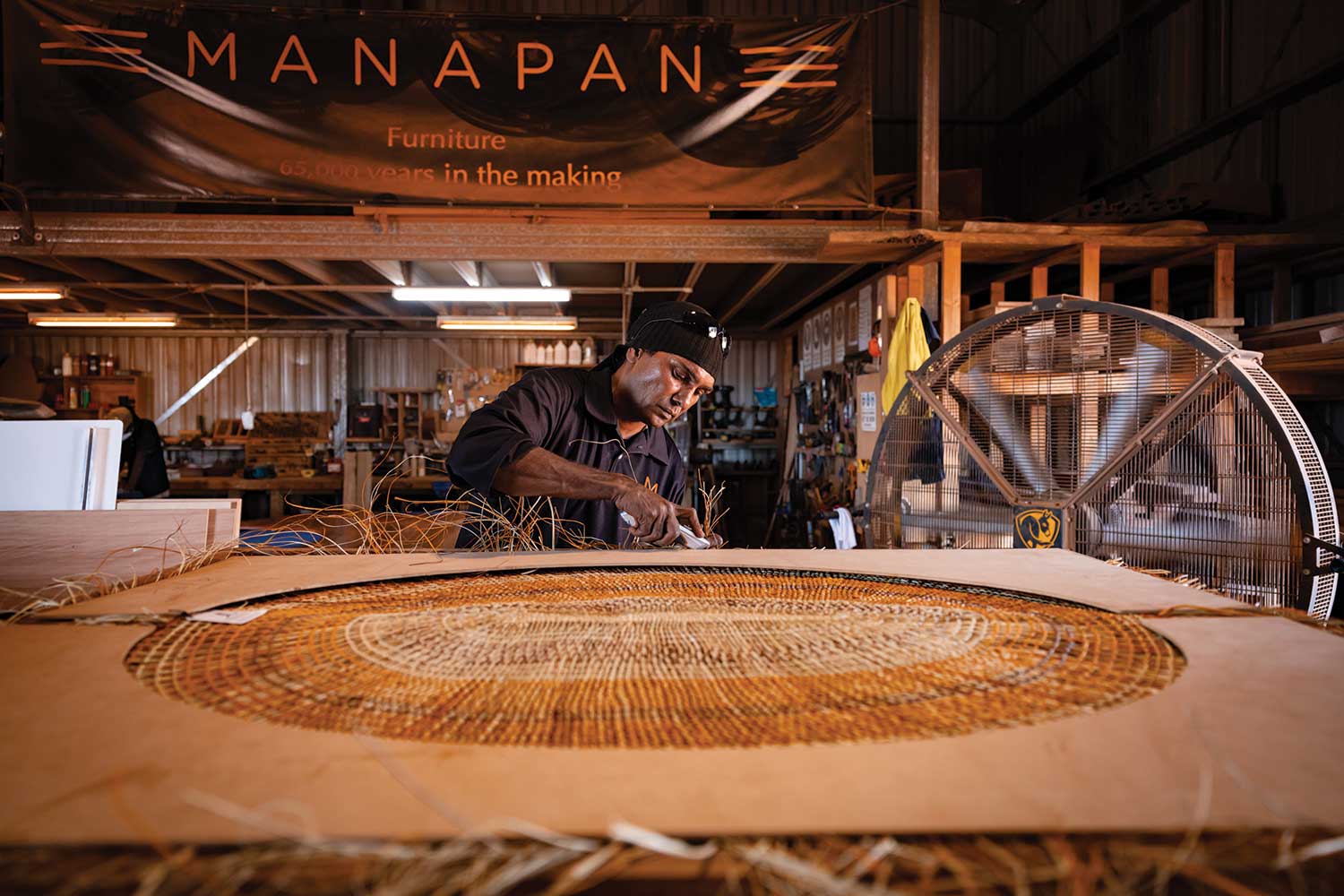
The Manapan designers working on the weaving wall
Of course, Cartier’s support for the Australian community extends beyond the world of artistic expression, as evidenced by Red Club x Cartier, a global membership community of multicultural social entrepreneurs established by Cartier in 2019. The 2024 edition of the Young Leader is being hosted by the Southeast Asia and Oceania chapter of Red Club, with the theme of “Tech for a Sustainable Future”, aiming to shine a light on youth-led, technology-driven solutions that aim to sustainably shape the world for a better future.
The world of Cartier encompasses timepieces like the Tank, but the Maison, and the culture it supports and creates is just as important, and equally timeless.
























